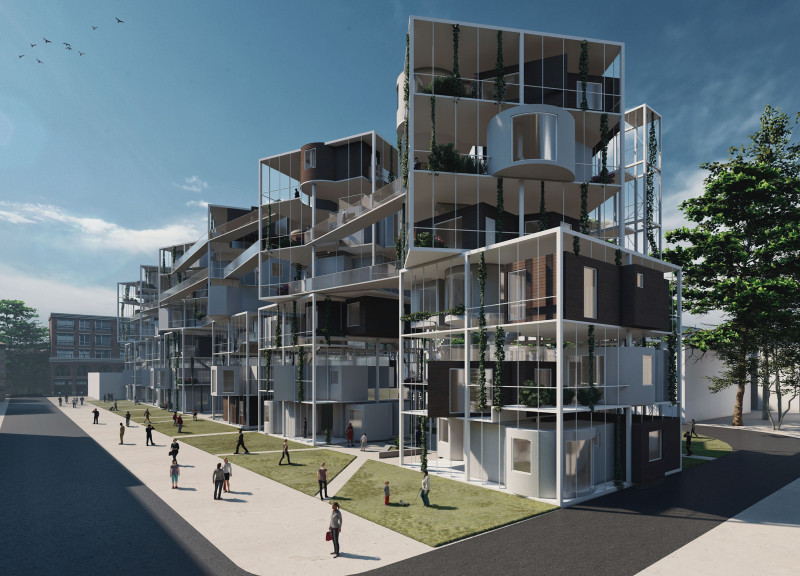5 key facts about this project
The core function of Pixel Housing is not only to provide living spaces but also to create a neighborhood atmosphere that encourages social engagement among residents. The project emphasizes communal areas, shared amenities, and pathways that invite residents to connect, fostering a sense of belonging and community cohesion. This design approach recognizes the importance of cultivating environments where individuals can maintain privacy while also interacting with their neighbors, thereby enhancing the overall quality of life.
Pixel Housing features a series of modular units that are visually organized in a staggered pattern, reminiscent of pixelation in digital design. This modularity allows for a variety of living configurations, accommodating singles, couples, and families alike. The architectural design employs a variety of materials, with an emphasis on sustainability and durability. The use of glass in the building's façade facilitates natural light penetration, creating bright interior spaces while promoting transparency with the surrounding environment. In addition to glass, the project incorporates natural wood finishes that add warmth and an organic quality to the structure, while steel elements provide necessary strength and stability.
Concrete plays a critical role in the foundational and structural components of the buildings, ensuring resilience over time. Importantly, the integration of green roof systems demonstrates a commitment to ecological sustainability. These green roofs not only contribute to biodiversity but also enhance thermal insulation and promote energy efficiency, making the project environmentally responsible.
The site plan is meticulously designed to maximize green spaces and encourage pedestrian movement. Communal gardens are interspersed throughout the development, providing residents with spaces for relaxation, socialization, and outdoor activities. The thoughtful arrangement of units around these communal spaces fosters interaction among neighbors and enhances the overall community atmosphere.
Additionally, the architectural sections of the project reveal well-thought-out vertical living arrangements. Each unit is designed to accommodate various demographic needs, ensuring that Pixel Housing caters to a wide array of residents. Single units maintain compact efficiency, couple units allow for more shared living space, and family units offer ample room for family activities while also providing private retreats for individual members.
One of the unique aspects of Pixel Housing is its emphasis on adaptability. The modular design allows for flexibility in unit configurations, enabling the project to respond effectively to changing demographic trends and lifestyle needs over time. This adaptability is a key consideration in modern urban architecture, allowing residences to evolve in tandem with shifting societal patterns.
Pixel Housing is a notable example of how architecture can contribute to the creation of more sustainable and interactive urban environments. The project not only serves as a residence but also as an integral part of the urban fabric of Toronto, promoting social interaction and sustainability. By delving deeper into architectural plans, sections, designs, and ideas, readers can gain further insights into how Pixel Housing successfully marries form with function, ultimately offering a model for future residential projects in urban settings. Explore the project to discover how it envisions community living in a contemporary context.























